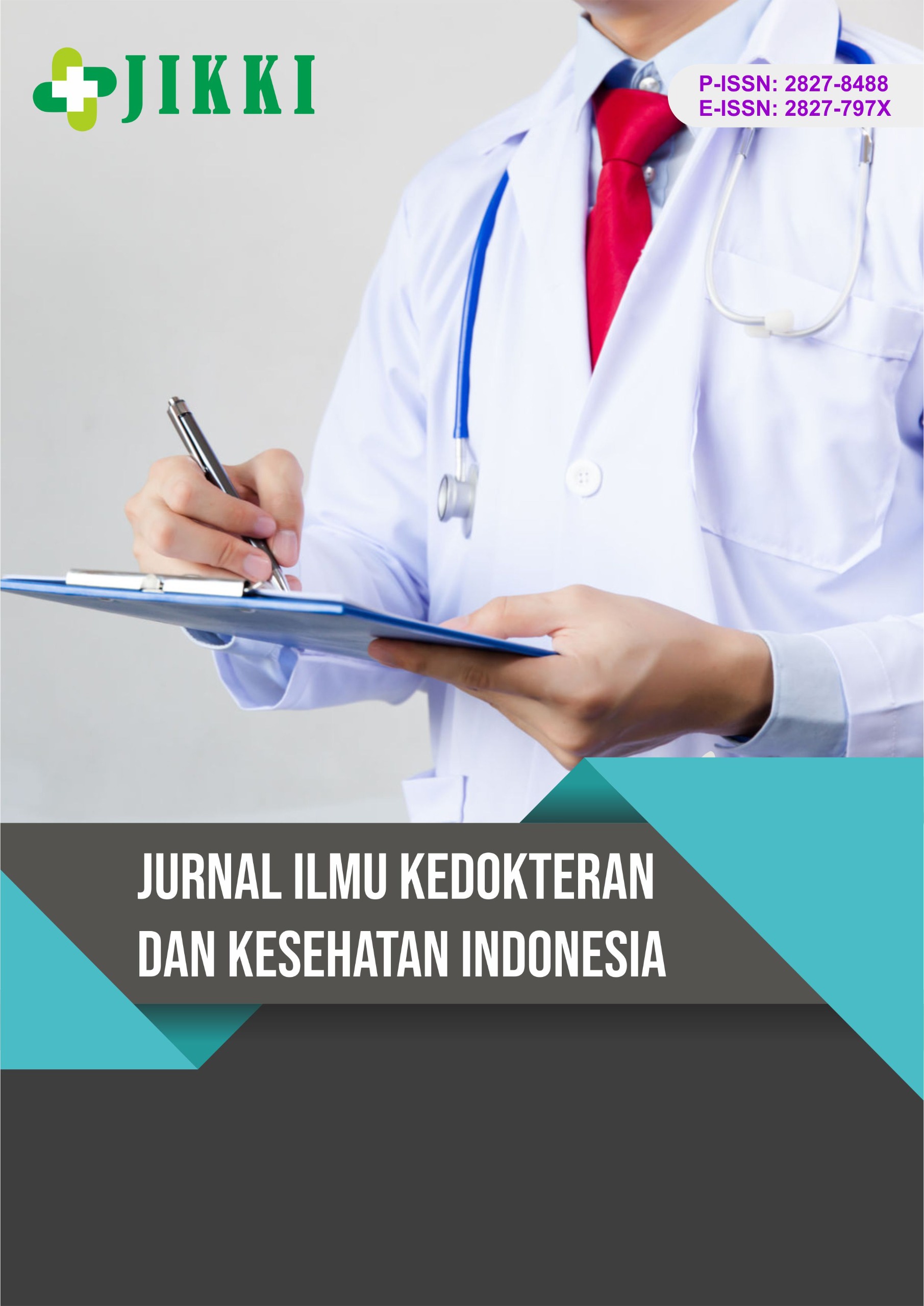Kesiapan Pelaksanaan Rekam Medis Elektronik (RME) dengan Pendekatan 5 M (Man, Money, Material, Machine, Methode)
Studi Kasus RSUM Ponorogo
DOI:
https://doi.org/10.55606/jikki.v5i3.8157Keywords:
Readiness, Electronic Medical Records, Man, Money, MaterialAbstract
Electronic Medical Record (EMR) is a system used to record medical information of patients electronically, which aims to facilitate and speed up the recording process. The use of EMR offers ease, practicality, and efficiency in patient data management (Yoga et al., 2020). This study aims to analyze the readiness of implementing EMR at the Muhammadiyah General Hospital in Ponorogo, based on the 5M management elements (Man, Money, Material, Machine, Method). The study uses a descriptive qualitative design with a case study approach, which was conducted through interviews to obtain data. The sample in this study consisted of 27 healthcare workers involved in using the EMR application. The sample was selected using purposive sampling. The results showed that the readiness of EMR implementation in terms of the Man element (human resources) is quite good, as most of the staff have demonstrated readiness in using the EMR application, as seen from their comfort and skills in operating the system. In terms of Money, the hospital has allocated sufficient funds for the maintenance of the EMR system, which is continuously updated, and for its implementation in the inpatient and Emergency Department (ED) areas. For the Material element, the software used for EMR is adequate and ready to support the implementation of the system. In the Machine element, the availability of computers and supporting devices, such as stable internet connections and servers, has been well established. The user-friendly system also supports the implementation process. Finally, the Method element shows that there are clear SOPs (Standard Operating Procedures) for EMR implementation and workflows that are easy to follow by the users. Overall, this study indicates that the Muhammadiyah General Hospital in Ponorogo is ready to implement the Electronic Medical Record system with strong support in all 5M management aspects.
References
Agung Pamuji, P. D. (2024). Systematic literature review: Faktor-faktor yang mempengaruhi implementasi rekam medis elektronik. Jurnal Kesehatan Masyarakat.
Alex, Sobur. (2016). Kamus Psikologi. Bandung: Pustaka Setia.
Amin, M., Setyonugroho, W., & Hidayah, N. (2021). Implementasi Rekam Medik Elektronik: Sebuah studi kualitatif. JATISI. https://doi.org/10.35957/jatisi.v8i1.557
Andriani, R., Kusnanto, H., & Istiono, W. (2017). Analisis kesuksesan implementasi rekam medis elektronik di RS Universitas Gadjah Mada. Jurnal Sistem Informasi, 13(2), 90-96. https://doi.org/10.21609/jsi.v13i2.544
Astuti, R., & Wulandari, F. (2021). Kesiapan petugas dalam peralihan dokumen rekam medis manual ke paperless pada unit rekam medis Puskesmas Kedungmundu Kota Semarang. Jurnal Dunia Kesmas, 10(1), 1-9. https://doi.org/10.33024/jdk.v10i1.3478
Azwar, A. (2010). Pengantar Administrasi Kesehatan. Tangerang: Binarupa Aksara Publisher.
Darsono. (2000). Belajar dan Pembelajaran. Semarang: IKIP Semarang Press.
Djamarah, S. (2017). Rahasia Sukses Belajar.
Depkes RI. (2006). Tentang pengertian rekam medis.
Dirjen Bina Pelayanan Medik. (2006). Pedoman Penyelenggaraan dan Prosedur Rekam Medis Rumah Sakit di Indonesia.
Febrianti, E. C., Nurmawati, I., & Muflihatin, I. (2020). Evaluasi rekam medis elektronik di tempat pendaftaran pasien gawat darurat dan rawat inap RSUD KRMT Wongsonegoro Kota Semarang. J-REMI: Jurnal Rekam Medik dan Informasi Kesehatan, 1(4), 537-544. https://doi.org/10.25047/j-remi.v1i4.2145
Hanafiah, A. (2008). Etika Kedokteran dan Hukum Kesehatan. Kedokteran EGC, Jakarta.
Handiwidjojo, W. (2022). Rekam medis elektronik. Jurnal EKSIS, 2(1), 36-41.
Hatta, G. R. (2013). Pedoman Manajemen Informasi Kesehatan Di Sarana Pelayanan Kesehatan. Jakarta: UI Press.
Hatta, G. R. (2014). Pedoman Manajemen Informasi Kesehatan Di Sarana Pelayanan Kesehatan. Jakarta: UI Press.
Herlyani, E., Koten, B., Ningrum, B. S., & Indonesia, U. (2020). ISSN 2654-6191 (Print). Carolus Journal of Nursing, 2(2), 95-110. https://doi.org/10.37480/cjon.v2i2.45
Indradi, R. (2014). Rekam medis. In: Sejarah Perkembangan, Pengertian Dasar Rekam Medis, dan PORMIKI. Universitas Terbuka, Jakarta.
Indawati, L., Widjaja, L., & Rumana, N. A. (2022). Literature review ketepatan pengodean ICD-10 External Cause di Rumah Sakit. Cerdika: Jurnal Ilmiah Indonesia, 2(9), 798-810. https://cerdika.publikasiindonesia.id/index.php/cerdika/article/view/445
Notoatmodjo, S. (2010). Metodologi Penelitian Kesehatan. Jakarta: Rineka Cipta.
Nuranni Avianti. (2023). Tinjauan kesiapan penerapan rekam medis elektronik di RSU Lukas Bangkalan. Sekolah Tinggi Ilmu Kesehatan Ngudia Husada, Madura. https://doi.org/10.33024/hjk.v17i6.12867
Nursalam. (2020). Metodologi Penelitian Ilmu Keperawatan. Penerbit Salemba Medika.
PERMENKES. (2009). No.269/MENKES/PER/III/2008 Tentang Penyimpanan Rekam Medis.
PERMENKES. (2009). Undang-Undang RI Nomor 44 Tahun 2009 Tentang Rumah Sakit.
PERMENKES. (2008). No.269/MENKES/PER/III/2008 Tentang Rekam Medis.
Potter, P. A., & Perry, A. G. (2009). Buku Ajar Fundamental Keperawatan (Edisi 4). Jakarta: EGC.
Rifki Kapitan Achmad, et al. (2023). Analisis kesiapan penerapan rekam medis elektronik di RSUD Bandar Negara Husada, Lampung.
Rusdiana. (2018). Kesiapan PTKIS Pusat Penelitian dan Penelitian UIN SGD: Bandung.
Syaiful Bahri Djamarah. (2002). Rahasia Sukses Belajar. Jakarta: Rineka Cipta.
Savitri. (2015). Pentingnya tracer sebagai kartu pelacak berkas rekam medis kelar dari rak penyimpanan. Indonesian Journal of Community Engagement, Vol. 01, No 01, September 2015.
Sudirahayu, I., & Harjoko, A. (2017). Analisis kesiapan penerapan rekam medis elektronik menggunakan DOQ-IT di RSUD Dr. H. Abdul Moeloek Lampung. Journal of Information Systems for Public Health, 1(3). https://doi.org/10.22146/jisph.6536
Supriyanto, S., & Wulandari. (2011). Pemasaran Industri Jasa Kesehatan. Yogyakarta: Andi.
Sugiyono. (2018). Metode Penelitian Kuantitatif, Kualitatif, dan R&D. Bandung: Alfabeta.
Sugiyono. (2019). Metode Penelitian Kuantitatif, Kualitatif, dan R&D. Bandung: Alfabeta.
Sutrisno, E. (2020). Manajemen Sumber Daya Manusia. Kencana Prenada Media Group, Jakarta.
Yoga, V. (2020). Analisis kesiapan penerapan rekam medis elektronik di RSUP dr. M. Djamil Padang. Jurnal Kedokteran Gigi Universitas Baiturahmah, 8(1), 71-82. https://doi.org/10.33854/jbd.v8i1.598
Undang-Undang RI Nomor 44 Tahun 2009 Tentang Rumah Sakit.
Undang-Undang Nomor 29 Tahun 2004 Tentang Praktik Kedokteran.
Undang-Undang Nomor 11 Tahun 2008 Tentang Informasi dan Transaksi Elektronik.
Vesri Yoga Bestari, et al. (2023). Analisis kesiapan penerapan rekam medis elektronik (RME) di RSUP Dr. M. Djamil Padang. Jurnal Kedokteran Gigi Universitas Baiturahmah, 8(1), 71-82. https://doi.org/10.33854/jbd.v8i1.598
Wasty Soemanto. (2012). Psikologi Pendidikan. Jakarta: Rineka Cipta.
Wirawan. (2009). Evaluasi Kinerja Sumber Daya Manusia: Teori Aplikasi dan Penelitian. Jakarta: Salemba Empat.
Downloads
Published
How to Cite
Issue
Section
License
Copyright (c) 2025 Jurnal Ilmu Kedokteran dan Kesehatan Indonesia

This work is licensed under a Creative Commons Attribution-ShareAlike 4.0 International License.








